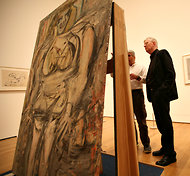Lately, it's been a trend for painters to site de Kooning as an influence; so much so that it has almost become trite. De Kooning is seen by many as one of the most important post-war painters, and is considered a "painter's painter." To look at de Kooning's career gives us a glimpse of what it is like not only to be a painter, but to be a star painter.
In November, MOMA gave up an entire floor of its museum to house a successful first time retrospective of Willem de Kooning. It included almost 200 works and a 500 page catalog. The retrospective showed de Kooning's work from the start of his career to finish.
Putting together the retrospective put to rest the myth of tortured artist working alone in a studio and shed light on how many people are involved in maintaining an artist's career. These include dealer, curator, collector, lawyer, critic and , when the artist dies, heirs and possibly a foundation.
When de Kooning's alzheimer's became severe, his wife, Elaine, took on responsibilities for maintaining his collection, as did their only daughter, Lisa. As with many estates of deceased artists, de Kooning's works were managed by a foundation set up for the artist. The foundation managed the estate and created a catalog of works. The estate had 1,334 works when it was started in 2003. Silberman, the president of the foundation says:
works are sold to pay for the administration of the foundation—whose stated purpose is to catalogue and maintain its own collection and archive and facilitate museum exhibitions and scholarly research about de Kooning. (Or, as Eastman describes its mission: “De Kooning is the greatest American artist ever. Prove it.”)
John Elderfield, curator of the retrospective at MOMA, explains that a major retrospective of this scale would not be possible without the help of Lisa de Kooning and the de Kooning Foundation. MOMA was given full access to the foundation's records detailing de Kooning's current wherabouts of works, and was assured loans of works from the foundation.
With the large scale retrospective with full access to records, photographs, and drawings, it was possible for scholars make new discoveries about his work process.
Elderfield preparing for the exhibition
Read more from Art News Here:
http://www.artnews.com/2011/09/08/shaping-de-koonings-legacy/



No comments:
Post a Comment